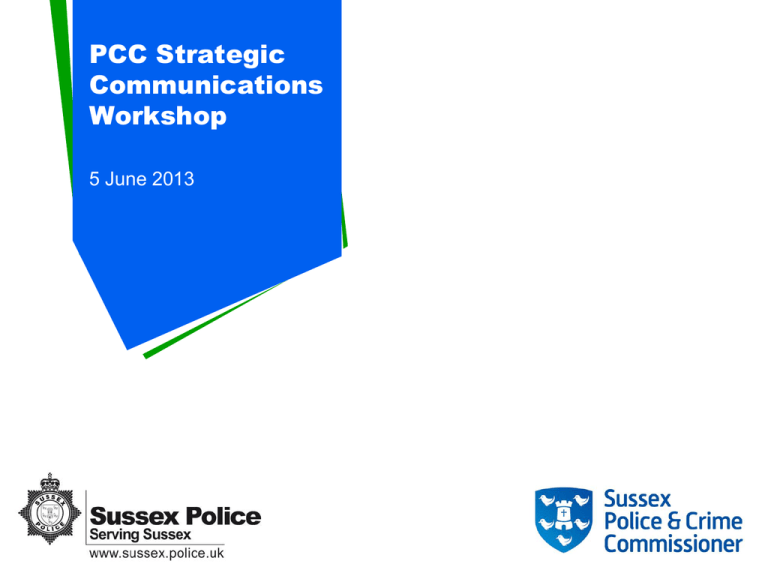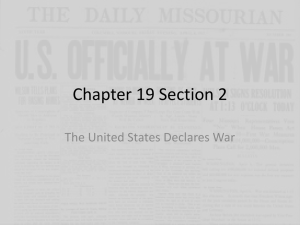130605 PCC Strat Comms workshop
advertisement

PCC Strategic Communications Workshop 5 June 2013 Overview Workshop outcomes Challenge common comms misconceptions Using comms as a strategic tool for change Recap PCC leadership brand and impact on comms Plot overarching comms strategy for full PCC term Identify hot stakeholders, issues and tactics Direct the priority comms activity for 2013-14 Golden rules for a successful session! Trust the process and don’t jump to outcomes/actions Everyone to interact, question and share their views Frank and open approach, confidentiality assurance Sussex Police | Serving Sussex 2 Strategic Communications doesn’t ‘Tell people things’ It identifies ‘What do you want people to think, feel and do differently?’ and helps make this happen Sussex Police | Serving Sussex 3 Myth-busting: Five common comms mistakes Spreading effort too thinly across multiple issues Better to tackle single priority issues sequentially Presuming message sent = message understood Seek feedback and monitor behavioural changes Hearing those who speak loudest Significant groups may be smaller and harder to hear Need means of access and encouragement to do so Over-emphasis on media relations and coverage Media reach and public trust continues to erode More people self-source (local TV is an exception) Thinking ‘no comment’ is still the cardinal sin Sometimes a carefully-worded ‘nothing’ is best! Sussex Police | Serving Sussex 4 Myth-busting: Five things strategic comms can’t do! Achieve change or have long-term impact alone Needs to be supported by wider organisational actions Deliver ‘something for nothing’… …although it can deliver ‘a lot for relatively little’! With investment of time, access and resources Achieve change or a lasting impact overnight Most effective strategic comms is planned, long-term Reactive responses important, but aligned to strategy Create entirely favourable media or public views Media continues to have a legitimate role to scrutinise Different stakeholders will view actions differently Defend the indefensible Organisations and people inevitably make mistakes Build public trust by putting hands up, not covering up Sussex Police | Serving Sussex 5 The more you want comms to achieve, the greater the difficulty… …but significant and real change is possible with a clear strategy, time, consistency and layering effective tactics Sussex Police | Serving Sussex 6 Strategic Comms as a tool for change Tackling Domestic Abuse under-reporting Changing internal attitudes, building advocacy and increasing victim confidence Now a valued tool for major crime investigations Building internal trust and access leads to innovation and operational impact Sussex Police | Serving Sussex 7 Brand, sphere and communications impact Personal brand operates across three spheres Internal values and motivators (some private) Visible personal leadership brand and styles As the personification of the Office (and vice-versa) Consistency across the three spheres Inconsistencies can be exposed (e.g. social media) Reputation of the Office is greater and longer-term than any individual, although it can evolve with them Points of distinction or alignment to the Force Both its senior individuals and its corporate brand Sussex Police | Serving Sussex 8 PCC leadership brand At the end of year one what does PCC Katy Bourne want to be known for: making a difference – and specifically to victims of Domestic Abuse For whom: Women, families, victims To what: Under-reporting – the process and treatment of victims What is Katy Bourne’s personal style: Upfront In the fray – leading Determined Innovative Sussex Police | Serving Sussex Physically engaging Focussed, seen to be focussed and delivering Committed 9 PCC leadership narrative What is the story Katy Bourne wants to tell? Katy Bourne really understands what it’s like for victims (particularly of DA & ASB) Focus on Victims – what’s the distinctive angle? The treatment of victims in the CJS Focus on Domestic Abuse – what’s the distinctive angle? Something that happens behind closed doors Affects all involved: especially families and children Ideal to lead nationally Sussex Police | Serving Sussex 10 Why Communications Strategy matters Building this long-term strategy and identifying priority tactics for the PCC Sussex Police | Serving Sussex 11 Stakeholder identification Pre-populated with common stakeholder groups and some identified PCC priorities Granulation is essential Don’t be scared to break-down wider groups If they have different triggers/concerns, split them Prioritisation and mapping Many models - important thing is to use one! Our suggested method merges two – measuring influence/engagement and positivity Sussex Police | Serving Sussex 12 Stakeholder prioritisation With colour-coded labels of likely view on the issue: • Positive (a potential advocate) • Neutral or unknown • Negative (a likely opponent) Engagement (how engaged they already are with you) Use the model to expand, Influence (how much they can affect or are affected by an issue) Sussex Police | Serving Sussex segment and prioritise the pre-populated groups Who are the top 3-5 over the full PCC term of office? 13 Outcome mapping At end of the current PCC term identify what you want your stakeholders to: Think Feel Do Specify ‘Ideal’ and ‘Acceptable’ outcomes Work back to identify definable and achievable milestones on a journey to these outcomes Sussex Police | Serving Sussex 14 Strategy into tactics and predicting pitfalls Tactics must be aligned to deliver your strategy and designed to reach different stakeholders Identify triggers, opportunities and challenges Need to invest more time and effort to achieve more ambitious outcomes (Think -> Feel -> Do) Four to six tactics using different channels over time is ten times more likely to have lasting behavioural impact than repeating the same tactics or deploying multiple tactics for a short time Spot the pits, so you don’t fall into them! Identify ‘big turn offs’ for each stakeholder to avoid Or tactics that could undermine your style and values Sussex Police | Serving Sussex 15 Triggers, opportunities and challenges Triggers for effective tactics can be Time-based (e.g. existing campaigns or seasonal) Values-based (e.g. family or financial motivations) Issues-based (things that matter most to that group) Be clear which triggers are: Opportunities (either existing or generated by you) Challenges – but identified early and proactively dealt with, they can turn into opportunities Apply this to your priority stakeholders and outcomes to identify potential triggers and tactics Sussex Police | Serving Sussex 16 Suggested way forwards Following this, the PCC Comms Team should ‘Fill in the blanks’ for other priority stakeholders Produce a ‘term of office’ Comms Strategy Finalise a 2013-14 Comms Delivery Plan Draw on CCPED to help design, deliver and review The Plan will set themes and phases, achieving milestones and outcomes set by the PCC Continually review milestones and outcomes in-year Re-run this session to review long-term priorities and set Comms Delivery Plan for 2014/15 Sussex Police | Serving Sussex 17 Any questions?






